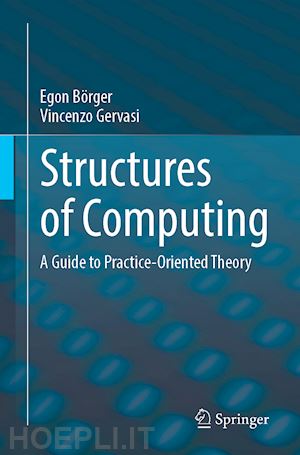

Questo prodotto usufruisce delle SPEDIZIONI GRATIS
selezionando l'opzione Corriere Veloce in fase di ordine.
Pagabile anche con Carta della cultura giovani e del merito, 18App Bonus Cultura e Carta del Docente
Structures of Computing explains the behavioral meaning of fundamental concepts of computing from a practical viewpoint and in generic terms, unrestricted by specific computing devices or programming languages. To compute is understood as processing structures by a set of cooperating agents each of which executes an algorithm assigned to it and interacts with the other agents.
Part I of the book defines the conceptual constituents of interactive processes: (i) data, i.e. structured objects with associated properties, relations and functions the algorithmic processes operate upon, (ii) basic operations that affect the data in single execution steps, and (iii) control mechanisms that determine the combination of single steps in multi-agent computations where the interaction happens via communication or other forms of data sharing.
Part II analyses these constituents concerning (i) methods to achieve process correctness (inspection, experimental validation, reasoning), (ii) principal computational paradigms (architectures, programming styles, communication structures, control patterns from sequential and reflective to concurrent, mixed synchronous/asynchronous and data flow control), and (iii) complexity (power and limits of computing structures).
The book is mainly addressed to students and professionals who want to understand the conceptual foundation of computing. It does not assume any specific programming experience but only a basic understanding of what are mechanically executable processes and their descriptions. Any unnecessary formalism is thus avoided, and definitions are formulated as much as possible in natural language, using common mathematical notation only where needed to prevent ambiguities. Numerous examples and exercises serve as comprehension checkpoints.
Egon Boerger has worked since 1972 as professor of computer science at the Universities of Salerno, Muenster, Dortmund, Udine and Pisa (since 1985). He spent sabbatical years with IBM, Siemens, Microsoft, SAP and ETH Zürich. He is the author of seven books on logic, computer science and modeling business processes. In 2007 he received the Humboldt Research Award for his work in logic and computer science. His current interest is in rigorous design and analysis methods for concurrent software-intensive systems.
Vincenzo Gervasi is an Associate Professor with the Computer Science Department of the University of Pisa, Italy. His main research interests lie in the cognitive aspects of the construction and comprehension of software. His current work areas include requirements engineering, software engineering, formal specifications, natural language processing, distributed algorithms and applications, and AI for biomedical applications. On these subjects he has published over 120 contributions in international venues. He is a member of IFIP WG 2.9 (Requirements Engineering).











Il sito utilizza cookie ed altri strumenti di tracciamento che raccolgono informazioni dal dispositivo dell’utente. Oltre ai cookie tecnici ed analitici aggregati, strettamente necessari per il funzionamento di questo sito web, previo consenso dell’utente possono essere installati cookie di profilazione e marketing e cookie dei social media. Cliccando su “Accetto tutti i cookie” saranno attivate tutte le categorie di cookie. Per accettare solo deterninate categorie di cookie, cliccare invece su “Impostazioni cookie”. Chiudendo il banner o continuando a navigare saranno installati solo cookie tecnici. Per maggiori dettagli, consultare la Cookie Policy.